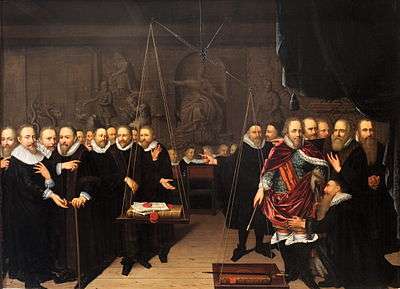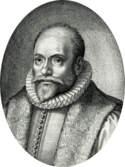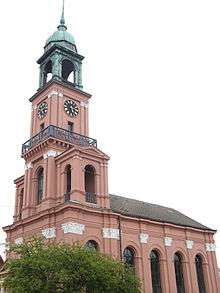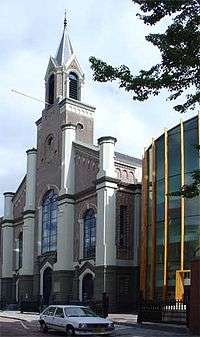Remonstrants

| Part of a series on |
| Arminianism |
|---|
 |
| Background |
| People |
| Doctrine |
|
|
The Remonstrants are a historic community of mostly[1] Dutch Protestants who originally supported Jacobus Arminius, and after his death, continue to maintain his original views. In 1610, they presented to the States of Holland and Friesland a remonstrance in five articles formulating their points of disagreement with Calvinism as adopted by the Dutch Reformed Church.[2][3]
There are 10,000 Remonstrants in the world. According to 2010 statistics, a 6,000-strong Remonstrant community still remains in the Netherlands. There is also a single congregation in Friedrichstadt, Schleswig-Holstein in Germany. The remaining Remonstrants are dispersed internationally.[4]
Name
As historic supporters of his theological cause, Remonstrants declined to be called "Arminians" (after the Roman Catholic practice of "naming heresy after its founder") and adopted a designation of their own choice.
Remonstrant vs. Arminian
Despite following the pure version of Arminianism, they are not the only Protestants who can be considered Arminian or be called "Arminians", as the Arminian movement is a cross-denominational development which made inroads into the Church of England, Methodism, General Baptists, the Holiness movement, the Charismatic movement, Pentecostalism and a number of other Protestant denominations.
History
|
|
| Conditional election |
| Unlimited atonement |
| Total depravity |
| Prevenient grace |
| Conditional preservation |
|
|

The five articles include:[5]
- that the divine decree of predestination is conditional, not absolute;
- that the Atonement is in intention universal;
- that man cannot of himself exercise a saving faith;
- that though the grace of God is a necessary condition of human effort, it does not act irresistibly in man; and
- that believers are able to resist sin but are not beyond the possibility of falling from grace.[3]
Their adversaries, inspired by Franciscus Gomarus, became known as Gomarists or Counter-Remonstrants.[3] Although the States-General issued an edict tolerating both parties and forbidding further dispute, the conflict continued[3] and became linked to political conflicts in the Dutch Republic. The Remonstrants were assailed both by personal enemies and by the political weapons of Maurice of Orange.[3] Their foremost ally, Johan van Oldenbarnevelt, was executed, and other leaders were imprisoned.
In 1618–19 the Synod of Dordrecht, after expelling the thirteen Arminian pastors headed by Simon Episcopius, established the victory of the Calvinist school.[3] It drew up ninety-three canonical rules, and confirmed the authority of the Belgic Confession and the Heidelberg Catechism.[3] The judgement of the synod was enforced through the deposition and in some cases banishment of Remonstrant ministers.[3] An exile community was founded in Antwerp in 1619. In 1621 they were allowed to settle in Schleswig, where they built the town of Friedrichstadt.[3]
The doctrine of the Remonstrants was embodied in 1621 in a confessio written by Episcopius, their major theologian, while Jan Uytenbogaert gave them a catechism and regulated their church order.[3] Their seminary in Amsterdam had distinguished pupils, including Curcellaeus, Limborch, Wetstein, and Le Clerc. Their school of theology, which grew more liberal and even rationalistic, forcefully debated the official Dutch Reformed state church and other Christian denominations.[3]
After the death of Maurice of Orange in 1625 some exiles returned. The government became convinced that they posed no danger to the state, and in 1630 they were formally allowed to reside again in all parts of the Republic.[3] They were not, however, officially allowed to build churches until the establishment of the Batavian Republic in 1795. Until then they held their services in so-called Schuilkerken (house churches).[6]
Modern Remonstrant Brotherhood

The Remonstrant Brotherhood continues as a church in the Netherlands. It has its origins in the theology of Arminius and the signing of the "Five articles of Remonstrance" against a stricter form of Calvinism by 44 ministers. The Remonstrants proclaimed the responsibility of man, pre-ordination through foreknowledge of faith, and that Christ's death was sufficient for all. In line with the progressive views on religion, Remonstrants have been blessing same-sex partnerships on an equal footing as different sex weddings from 1986 onwards (church weddings have no legal status in the Netherlands, where the legally acknowledged civil same-sex marriages became possible in 2001).[7][8] In this the Remonstrants were the first Christian church in the world to bless same-sex relationships similar to other relations.[9]
The Remonstrants first received official recognition in 1795. Their chief congregation has been in Rotterdam. Today, the Remonstrant Brotherhood has some 5,780 members and "friends", in 46 congregations in the Netherlands, and one congregation in Friedrichstadt, in northern Germany (2008). It keeps fellowship with the European Liberal Protestant Network.
Remonstrants place big emphasis on personal faith and are not in agreement with one another on questions of faith and social issues. They consider that the message of the Gospel can not be separated from true choices in the struggle to live together, on the road to a world with peace and justice.[10] What binds them is the Statement of Principle:
The Remonstrant Church is a community of faith which,
rooted in the gospel of Jesus Christ,
and true to its principle of freedom and tolerance,
seeks to worship and serve God.
Confessions of faith
In addition to Statement of Principle, most contemporary Remonstrants write their own declaration or profession of faith when they become a member of the community. The brotherhood did express at three times in their history the faith they share in a confessional statement, in 1621, 1940 and 2006. Remonstrants however, being a non-creedal denomination, consider no confession to have indisputable authority.[11]
| Confession 2006 | Confession 1940 [12] |
|---|---|
| We are aware and we affirm, that we do not find our peace in the certainty of what we confess, |
We believe in the holy, almighty God, our Creator and Lord, |
See also
References
- ↑ Today, there are also Germans and Frisians among the Remonstrant community.
- ↑ https://www.britannica.com/event/Remonstrant
- 1 2 3 4 5 6 7 8 9 10 11 12

- ↑ http://www.remonstranten.org/friedrichstadt/
- ↑ http://www.crivoice.org/creedremonstrants.html
- ↑ Benedict, Philip (2008). Christ's Churches Purely Reformed: A Social History of Calvinism. p. 313.
- ↑ "advies aan commissie Kortmann". Remonstranten.org. Retrieved 2012-09-09.
- ↑ "Kerken komen uit de kast". Kerknieuws.nl. Retrieved 2012-09-09.
- ↑ "Remonstranten en Boomsma krijgen homo-emancipatieprijs - Nieuws - TROUW" (in Dutch). Trouw.nl. 2010-01-25. Retrieved 2012-09-09.
- ↑ "Remonstrant Church". Landelijk Bureau Remonstranten. Retrieved 2016-01-23.
- ↑ "the Remonstrant Church - What we believe". Landelijk Bureau Remonstranten. 2007-05-29. Retrieved 2016-01-23.
- ↑ "Belijdenis". Landelijk Bureau Remonstranten. Retrieved 2016-01-23.
- Aken, Lucie J N K van, 1947. De Remonstrantse Broederschap in Verleden en Heden. Historische Schets, Arnhem: Van Loghum Slaterus
- Brouwers, J F e.a. (red), 2005. Wat We Nog Weten. Amsterdamse Remonstranten in de 20ste eeuw. 375-jarig Bestaan Remonstrantse Gemeente Amsterdam, Amsterdam: Remonstrantse Gemeente Amsterdam
- Barnard, T, 2006. Van verstoten kind tot belijdende kerk: de Remonstrantse Broederschap tussen 1850 en 1940, Amsterdam: De Bataafsche Leeuw
- Barnard, T en E Cossee, 2007. Arminianen in de Maasstad: 375 jaar Remonstrantse Gemeente Rotterdam, Amsterrdam: De Bataafsche Leeuw
- Cossee, E, 1988. Abraham des Amorie van der Hoeven, 1798-1855: een Remonstrants theoloog in de Biedermeiertijd, Kampen: Kok
- Cossee, E, Th M van Leeuwen, M A Bosman-Huizinga, 2000. De remonstranten, Kampen: Kok
- Episcopius, Simon, 1627. Vrye godes-dienst, of t'Samen-spreeckinghe tusschen Remonstrant en Contra-Remonstrant, over de vrye godts-dienstighe vergaderinghen der Remonstranten.: Met wederlegginge van Douchers oproerighe predicatie: C. Dungani redeloose salvatien, &c.
- Goud, J en K Holtzapffel (red), 2004. Wij Geloven - Wat Geloven Wij?. Remonstrants Belijden in 1940 en Nu. Zoetermeer: Meinema
- Keune, W T, C Ginjaar, J Schaafstra, 1978. Doopsgezind en Remonstrant in Dokkum, Van der Helm
- Sirks, G J, 1955. Verantwoording en verantwoordelijkheid van ons Remonstrant-zijn, Lochum: De Tijdstroom
- Slis, P L, 2006. De Remonstrantse Broederschap: Biografische Naamlijst, 1905-2005 : Gemeenten, Landelijke Organen, Predikanten en Proponenten, Publicaties, Eburon
- Vuyk, Simon, 2002. De Dronken Arminiaanse Dominee. Over de Schaduwzijde der Verlichte Remonstranten, Amsterdam: De Bataafsche Leeuw